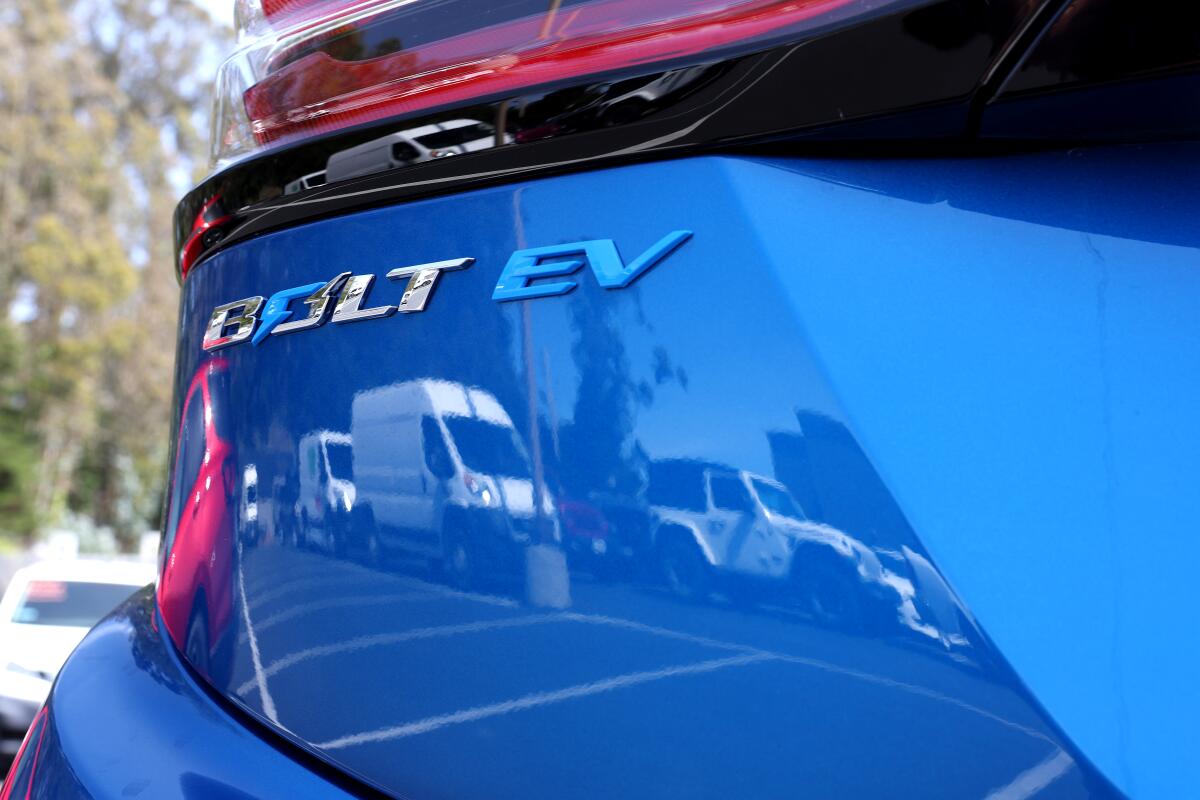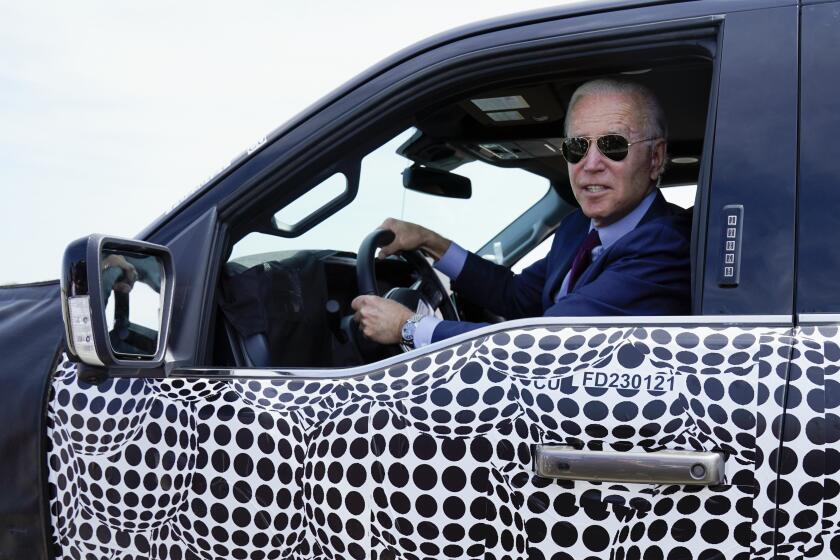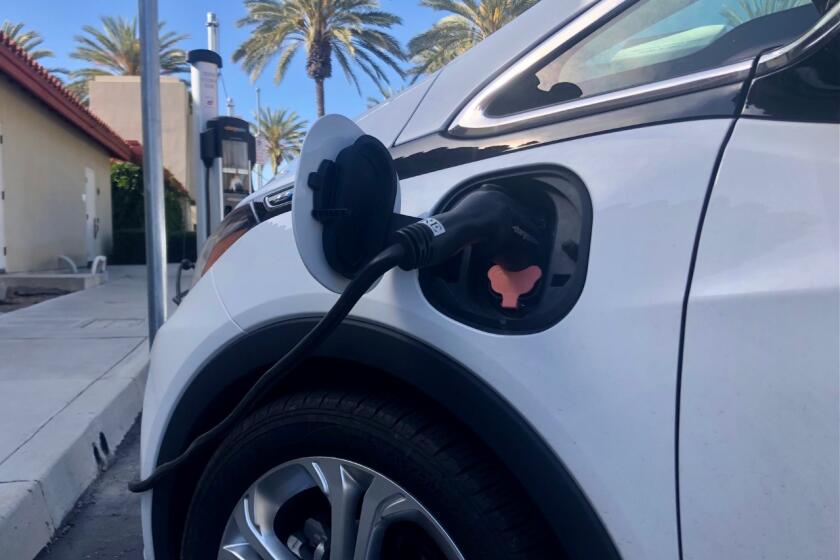Editorial: Replacing the Chevy Bolt with electric SUVs would be a climate tragedy

- Share via
Can we pour one out for the Chevy Bolt?
When the small electric hatchback came onto the market six years ago, it was a game changer: The relatively affordable battery-powered vehicle with 238 miles of range on a single charge demonstrated the mass-market potential for EVs.
The Bolt has only grown in popularity, as its range improved, gas prices spiked and sticker price cuts made it one of the cheapest electric vehicles on the market. If you can find one for the suggested retail price of $26,500, you could get it for less than $20,000 after the $7,500 federal tax credit.
But last week, General Motors Chief Executive Mary Barra announced the company will end production of the Bolt at the end of the year as it reconfigures the Michigan plant where it is made to build large battery-powered pickup trucks. Not only does it echo GM’s decision a generation ago to kill off the EV1, its first fully electric vehicle, but the Bolt’s demise is a disappointment for consumers and a step backward in the fight against climate change, including President Biden’s goal of cutting the nation’s air pollution in half by 2030.
Discontinuing a small, lower-cost EV like the Bolt to make room for bigger, more expensive models will make it harder for Americans to afford to go electric. This is the wrong direction to be heading when the U.S. needs to replace polluting gas- and diesel-powered cars and trucks with clean, zero-emissions vehicles quickly.
It’s terrible for consumers as well and undermines the message that everyone should dump their gas guzzlers soon. President Biden should figure out how to expand incentives for more electric vehicles.
The decision continues a long-standing trend in gas-powered vehicles. Automakers have largely phased out sedans and hatchbacks in favor of gas-guzzling SUVs that bring them fatter profits. Pickup trucks, SUVs and vans now make up nearly 80% of the U.S. auto market. And vehicles keep getting bigger and heavier, weighing more, on average, today than they did in the 1970s. The death of the Bolt signals that trend is unlikely to change with EVs. That’s a shame.
“The industry has decided that if they’re going to have to make EVs, they might as well make the same gigantic behemoths that they’ve been making before,” said Dan Becker, who directs the Center for Biological Diversity’s Safe Climate Transport Campaign.
Electric vehicles are on the whole better for the planet than gas-powered vehicles, but bigger, heavier and less efficient EV models have more environmental impacts than smaller ones. They are more deadly to pedestrians and other drivers, have larger batteries that use more electricity — much of which, for now, is still generated by natural gas and other fossil fuels — and they require more critical minerals and other raw materials to manufacture.
Cody Williams, a Chevrolet spokesperson, said that “Bolt EV was the first long-range, affordable EV offered by a high-volume full-line vehicles manufacturer” and that the company is passing the baton to new models using a new Ultium battery, including the 2024 Equinox EV, a midsize SUV that is “is expected to be one of the most affordable EVs in its class.” The automaker has said the Equinox EV will start at “around $30,000.”
The Biden administration’s proposed vehicle emission standards would effectively require that two-thirds of cars sold in the U.S. are zero-emission models in a decade.
That’s not too reassuring. Consumer groups are right to be worried that discontinuing lower-priced models like the Bolt will reduce options and shut out an entire segment of drivers who want to buy electric cars but won’t be able to afford them.
So what can be done to push back against ballooning sizes and price tags?
New auto emissions standards proposed last month by the U.S. Environmental Protection Agency, which would require about two-thirds of new passenger vehicles sold by 2032 to be electric, could be retooled to provide greater incentive for automakers to produce smaller, more efficient and affordable models.
California lawmakers are considering a proposal that could charge car owners a fee for registering heavier vehicles. It’s a small but important step.
The National Highway Traffic Safety Administration could adopt standards to push automakers to produce smaller, lighter vehicles that would be less dangerous in crashes. California lawmakers are already considering legislation to study the costs and benefits of charging car owners more for registering heavier vehicles, in recognition of the link between bigger vehicles and pedestrian injuries and deaths.
Rules adopted by California regulators last year to phase out sales of new gas-powered cars by 2035 include incentives to produce cars that sell for about $20,000 or less. But those provisions are optional, and Air Resources Board spokesperson Lys Mendez acknowledged “there’s not a lot we can do to mandate the kind of cars manufacturers provide.”
That makes it more important than ever that California continue to modernize and streamline its clean-vehicle rebate programs, which have been hampered by long waiting lists and inconsistent and insufficient funding that have prevented people from buying electric cars. The state recently increased incentives for low and moderate-income Californians to buy zero-emission vehicles, allowing them to apply for rebates of up to $7,500. But more can be done to smooth out these programs, such as making them redeemable at the dealership or point of sale rather than forcing car buyers with limited incomes to wait months for reimbursement.
The Bolt may be on its deathbed. But it doesn’t have to stall the EV revolution if we can find ways to push automakers to build more small, zero-emission cars that most people can afford to buy.













